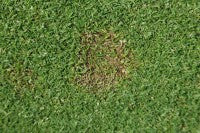DFence bill cuts fungicide costs at Chipping Sodbury
 A new bio-stimulant that boosts the turf's natural defence mechanisms has helped keep fusarium at bay and cut winter fungicide bills by £3-4000 at Chipping Sodbury Golf Course.
A new bio-stimulant that boosts the turf's natural defence mechanisms has helped keep fusarium at bay and cut winter fungicide bills by £3-4000 at Chipping Sodbury Golf Course.
Head Greenkeeper, John Keenaghan was introduced to DFence by Countrywide's Martin Townsend and opted to trial the product as part of a more holistic, natural approach to greens management being adopted at the club.
Nine month's on he's convinced that the product plays a major role in helping harden the grass and keeping his greens virtually disease free.
John has been Head Greenkeeper at Chipping Sodbury for just over two years. The course, north of Bristol - is a 102 year old 18 hole, parkland course. With 700 members and attracting £70k per year in visiting green fees, it is one of the most popular golf courses in Gloucestershire.
There are competitions most weekends and local children are encouraged to use the free 6 hole academy course and since 2005 the club has implemented a policy of playing on the greens all year round, which had not always been the case previously.
Being a 70:30 poa:bent mix, the old clay 'push-up' constructed greens were built in 1970 and suffer from considerable fusarium pressure. "Fusarium is the main disease, but anthracnose is also an issue," he says. "While we do tend to suffer from more disease where we are, the poorly drained nature of the greens doesn't help either.
"We are also a 'grass factory' and have to be out cutting all the time. This too weakens the grass and causes it to sweat, leaving the leaf open to attack."
Four or five years ago, Chipping Sodbury used up to eight applications of fungicide every year. Now, with the backing of the Golf Club General Manager, Bob Williams and in conjunction with the Deputy Head greenkeeper, Tim Needham, they have set about introducing cultural practices to toughen the turf.
"The club in effect gave us free reign to do what we felt best on what is a major course. When we started there was up to 2.5" of thatch," says John. "Now, every three weeks, we solid tine to depths varying from 5 to 8 or 12mm and top-dress."

Three years ago almost 300kg of granular nitrogen fertiliser was applied to the course. Last year though, John and Tim left the course 'lean and hungry', using just 106kg N - the year before having cut back to 124kg. "As the turf hardens and builds its strength, we'd like to get this below 100kg," says John. "Too much weak growth adds to the pressure cooker effect and disease pressure."
In John's opinion, many greenkeepers - encouraged by their membership - continue to over-water greens and this also helps build the disease pressure. Now at Chipping Sodbury he'll give the greens a good soak only when they really need it.
In a further move to improve natural resistance of the turf, the course alternates cuts with a vibrating roller. According to Tim Needham, regularly cutting the top off the leaf places continual stress on the plant and allows guttation fluid to be released providing the moisture that the disease requires. "Healthy grass will fight its own battles," he says.
As a result of all these practices, thatch has been reduced and rooting has improved to the extent that there is now 4-5" of root structure before you get down to the heavy, blue clay base on which the greens are constructed. Next year, John will be looking at a drill and fill system to help improve the natural drainage of the course.
This year, following Countrywide's advice, DFence was applied at 10l/hectare starting in October - after aerating by solid-tining - and then every four to five weeks. At the same time a low nitrogen Liquid Pro Turf, 3:0:3 formulation was applied. The aim; to try and reduce the course's heavy reliance on fungicides.
"This produced a lovely colour; the greens look superb and the members were delighted," says John. "However, more importantly and despite high pressure, the first fungicide wasn't needed until May 30th. "Prior to using DFence, we'd be using a fungicide after every feed as the sward environment altered with the additional nutrients favouring the disease.
"We were astonished with how the DFence worked," he recalls. "We are convinced it boosts the anti-bodies of the plant and we saw no fusarium patch for months - in-fact it never came, and this despite a mild Christmas, heavy dews in the spring and plenty of soft, early season growth.
 "Even after early hollow tining and then top-dressing, there was no significant disease threat. In the end the DFence probably saved us around £3-4000 in fungicide costs through the winter months," he points out
"Even after early hollow tining and then top-dressing, there was no significant disease threat. In the end the DFence probably saved us around £3-4000 in fungicide costs through the winter months," he points out
Looking at the wider picture, the new regime at Chipping Sodbury has been able to cut input costs from £110,000 to around £89,000/year. "This £20,000/yr saving is largely through fertiliser and fungicide use and DFence has been a key factor in securing this," says John.
However, Mr Keenaghan and his team won't rest on their laurels. "We are trying to raise the bar still further, improving our course definition and playing surfaces all the time in order to compete with the larger, wealthier, courses in our area.
"We are going to go more down the organic line, but by using products that we know work. We'll also continue to find ways of hardening the turf and boosting its natural resistance," he says.
